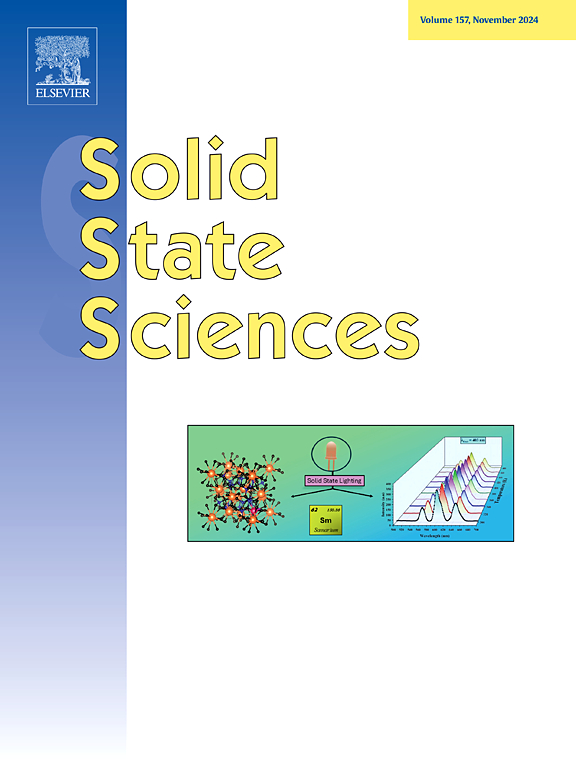Exploring the luminescence and photometric behavior of green emitting NUV excited Er3+ doped Ca9Y(PO4)7 nanophosphor: A promising material for solid-state illumination applications
IF 3.4
3区 化学
Q2 CHEMISTRY, INORGANIC & NUCLEAR
引用次数: 0
Abstract
The unparalleled ability of nanosized rare-earth activated phosphors stimulated by near ultraviolet (nUV) light to provide efficient visible emission has garnered huge interest as excellent sources for next-generation solid-state illumination devices. Herein, we have proposed bright green emitting Er3+ doped Ca9Y(PO4)7 nanomaterials for application prospects in optoelectronic technology owing to its magnificent down-conversion luminescence. The phase purity and structure, surface morphology, photophysical features (e.g., excitation and emission spectra, concentration quenching, decay curves, optical energy band gap etc.) of Ca9Y(PO4)7: Er3+ nanophosphors were investigated systematically. Phase purity and space group (trigonal with R3c(161)) of synthesized nanophosphors Ca9Y(PO4)7: Er3+ were confirmed by high quality powder X-ray diffraction data. The scanning electron microscope (SEM) and high-resolution transmission electron microscope (HRTEM) images have been captured to examine surface characteristics and crystallite dimensions of Ca9Y(PO4)7: Er3+ nanoparticles. Constituent elements of phosphors were determined by EDAX spectroscopy to depict high purity. Ca9Y(PO4)7: Er3+ nanophosphors perform bright green emission under NUV excitation of 381 nm. The greenish light emitted at 564 nm is attributed to the transition 4S3/2 → 4I15/2 of Er3+ ions. The optimal activator concentration is 10 mol %, beyond which concentration quenching attributed to electric multipolar interactions was observed as studied via Dexter's and Van-Uitert's theoretical model. The conducting performance of the Ca9Y(PO4)7: Er3+ nanophosphors is authenticated by their optical energy gap calculation using Kubleka-Munk and Tauc's hypothesis which falls in wide band-gap semiconductor regime. Decay curve and photoluminescent lifespan analysis using Auzel's model established high quantum efficiency of synthesized nanophosphors. The photometric features like CIE color coordinates, CCT suggested the exceptional potential of Ca9Y(PO4)7: Er3+ nanophosphors for use as a bright green emitting segment in NUV based cool pc-WLEDs. Such NPs have interesting applications in emerging optoelectronic devices, hence rendering them of profound utility in the near future as promising contenders for near-ultraviolet (NUV) chip-based WLEDs and solid-state lighting surpassing the commercially available traditional light sources.

探索绿色发射NUV激发Er3+掺杂Ca9Y(PO4)7纳米荧光粉的发光和光度行为:一种有前景的固态照明材料
纳米级稀土活化荧光粉在近紫外(nUV)光刺激下提供高效可见发射的无与伦比的能力,已成为下一代固态照明器件的优秀光源,引起了人们的极大兴趣。在此,我们提出了亮绿色发光Er3+掺杂Ca9Y(PO4)7纳米材料,由于其出色的下转换发光,在光电技术中具有应用前景。系统地研究了Ca9Y(PO4)7: Er3+纳米荧光粉的相纯度和结构、表面形貌、光物理特性(如激发和发射光谱、浓度猝灭、衰减曲线、光学能带隙等)。用高质量的粉末x射线衍射数据证实了合成的纳米荧光粉Ca9Y(PO4)7: Er3+的相纯度和空间基团(与R3c(161)呈三角关系)。利用扫描电子显微镜(SEM)和高分辨率透射电子显微镜(HRTEM)对Ca9Y(PO4)7: Er3+纳米粒子的表面特征和晶粒尺寸进行了研究。用EDAX光谱法测定了荧光粉的组成元素,纯度高。Ca9Y(PO4)7: Er3+纳米荧光粉在381 nm的紫外激发下呈现亮绿色发光。在564 nm处发出的绿光归因于Er3+离子的4S3/2→4I15/2跃迁。激活剂的最佳浓度为10 mol %,通过Dexter's和Van-Uitert's理论模型研究发现,超过该浓度时,电多极相互作用会导致浓度猝灭。采用Kubleka-Munk和tac假设计算了Ca9Y(PO4)7: Er3+纳米荧光粉的光能隙,验证了其导电性能。利用Auzel模型进行衰减曲线和光致发光寿命分析,确定了合成纳米荧光粉的高量子效率。光度计特征,如CIE色坐标,CCT表明,Ca9Y(PO4)7: Er3+纳米荧光粉在基于NUV的冷pc- wled中作为亮绿色发光段具有特殊的潜力。这种NPs在新兴光电器件中有着有趣的应用,因此在不久的将来,它们将成为近紫外(NUV)芯片wled和固态照明的有力竞争者,超越商业上可用的传统光源。
本文章由计算机程序翻译,如有差异,请以英文原文为准。
求助全文
约1分钟内获得全文
求助全文
来源期刊

Solid State Sciences
化学-无机化学与核化学
CiteScore
6.60
自引率
2.90%
发文量
214
审稿时长
27 days
期刊介绍:
Solid State Sciences is the journal for researchers from the broad solid state chemistry and physics community. It publishes key articles on all aspects of solid state synthesis, structure-property relationships, theory and functionalities, in relation with experiments.
Key topics for stand-alone papers and special issues:
-Novel ways of synthesis, inorganic functional materials, including porous and glassy materials, hybrid organic-inorganic compounds and nanomaterials
-Physical properties, emphasizing but not limited to the electrical, magnetical and optical features
-Materials related to information technology and energy and environmental sciences.
The journal publishes feature articles from experts in the field upon invitation.
Solid State Sciences - your gateway to energy-related materials.
 求助内容:
求助内容: 应助结果提醒方式:
应助结果提醒方式:


